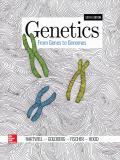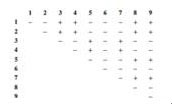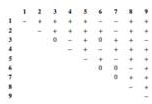
EBK GENETICS: FROM GENES TO GENOMES
6th Edition
ISBN: 9781260041255
Author: HARTWELL
Publisher: MCGRAW HILL BOOK COMPANY
expand_more
expand_more
format_list_bulleted
Concept explainers
Textbook Question
Chapter 7, Problem 34P
Nine rII- mutants of bacteriophage T4 were used in pairwise infections of E. coli K(λ) hosts. Six of the mutations in these phages are point mutations; the other three are deletions. The ability of the doubly infected cells to produce progeny phages in large numbers is scored in the following chart.

The same nine mutants were then used in pairwise infections of E. coli B hosts. The production of progeny phages that can subsequently lyse E. coli K(λ) hosts is now scored. In the table, 0 means the progeny do not produce any plaques on E. coli K(λ) cells; − means that only a very few progeny phages produce plaques; and + means that many progeny produce plaques (more than 10 times as many as in the − cases).

| a. | Which of the mutants are the three deletions? What criteria did you use to reach your conclusion? |
| b. | If you know that mutation 9 is in the rIIB gene, draw the best genetic map possible to explain the data, including the positions of all point mutations and the extent of the three deletions. |
| c. | One uncertainty should remain in your answer to part (b). How could you resolve this uncertainty? |
Expert Solution & Answer
Want to see the full answer?
Check out a sample textbook solution
Students have asked these similar questions
. Consider a base substitution mutation that occurred in a DNA sequence that resulted in a change in the
encoded protein from the amino acid glutamic acid to aspartic acid. Normally the glutamic acid amino acid
is located on the outside of the soluble protein but not near an active site.
O-H¨
A. What type of mutation occurred?
O-H
B. What 2 types of chemical bonds are found in the R-groups
of each amino acid? The R groups are shaded.
CH2
CH2
CH2
H2N-C-COOH
H2N-C-COOH
1
H
Glutamic acid
H
Aspartic acid
C. What 2 types of bonds could each R-group of each of these amino acids form with other molecules?
D. Consider the chemical properties of the two amino acids and the location of the amino acid in the
protein. Explain what effect this mutation will have on this protein's function and why.
engineered constructs that consist of hollow fibers are acting as synthetic capillaries, around which cells have been loaded. The cellular space around a single fiber can be modeled as if it were a Krogh tissue cylinder. Each fiber has an outside “capillary” radius of 100 µm and the “tissue” radius can be taken as 200 µm. The following values apply to the device:R0 = 20 µM/secaO2 = 1.35 µM/mmHgDO2,T = 1.67 x 10-5 cm2/secPO2,m = 4 x 10-3 cm/secInstead of blood inside the fibers, the oxygen transport and tissue consumption are being investigated by usingan aqueous solution saturated with pure oxygen. As a result, there is no mass transfer resistance in the synthetic“capillary”, only that due to the membrane itself. Rather than accounting for pO2 variations along the length ofthe fiber, use an average value in the “capillary” of 130 mmHg.Is the tissue fully oxygenated?
Molecular Biology
Please help with question. thank you
You are studying the expression of the lac operon. You have isolated mutants as described below. In the presence of glucose, explain/describe what would happen, for each mutant, to the expression of the lac operon when you add lactose AND what would happen when the bacteria has used up all of the lactose (if the mutant is able to use lactose).5. Mutations in the lac operator that strengthen the binding of the lac repressor 200 fold
6. Mutations in the promoter that prevent binding of RNA polymerase
7. Mutations in CRP/CAP protein that prevent binding of cAMP8. Mutations in sigma factor that prevent binding of sigma to core RNA polymerase
Chapter 7 Solutions
EBK GENETICS: FROM GENES TO GENOMES
Ch. 7 - The following is a list of mutational changes. For...Ch. 7 - What explanations can account for the following...Ch. 7 - The DNA sequence of one strand of a gene from...Ch. 7 - Among mammals, measurements of the rate of...Ch. 7 - Over a period of several years, a large hospital...Ch. 7 - Suppose you wanted to study genes controlling the...Ch. 7 - In a genetics lab, Kim and Maria infected a sample...Ch. 7 - The results of the fluctuation test Fig. 7.5 were...Ch. 7 - The following pedigree shows the inheritance of a...Ch. 7 - Autism is a neurological disorder thought to be...
Ch. 7 - Like the yellow Labrador retrievers featured in...Ch. 7 - Remember that Balancer chromosomes prevent the...Ch. 7 - Figure 7.14 shows examples of base substitutions...Ch. 7 - Figure 7.14a shows the mutagen 5-bromouracil 5-BU,...Ch. 7 - So-called two-way mutagens can induce both a...Ch. 7 - In 1967, J. B. Jenkins treated wild-type male...Ch. 7 - When a particular mutagen identified by the Ames...Ch. 7 - Prob. 18PCh. 7 - The Ames test uses the reversion rate His- to His...Ch. 7 - The mutant FMR-1 allele that causes fragile X...Ch. 7 - The physicist Stephen Hawking, famous for his...Ch. 7 - Aflatoxin B1 is a highly mutagenic and...Ch. 7 - In human DNA, 70 of cytosine residues that are...Ch. 7 - Bromodeoxyuridine BrdU is a synthetic nucleoside...Ch. 7 - Albinism in animals is caused by recessive...Ch. 7 - a. In Figure 7.22b, what can you say about the...Ch. 7 - Imagine that you caught a female albino mouse in...Ch. 7 - Plant breeders studying genes influencing leaf...Ch. 7 - In humans, albinism is normally inherited in an...Ch. 7 - a. Seymour Benzers fine structure analysis of the...Ch. 7 - a. You have a test tube containing 5 ml of a...Ch. 7 - Prob. 32PCh. 7 - The rosy ry gene of Drosophila encodes an enzyme...Ch. 7 - Nine rII- mutants of bacteriophage T4 were used in...Ch. 7 - In a haploid yeast strain, eight recessive...Ch. 7 - In Problem 24, you learned that Bloom syndrome is...Ch. 7 - The pathway for arginine biosynthesis in...Ch. 7 - In corn snakes, the wild-type color is brown. One...Ch. 7 - In a certain species of flowering plants with a...Ch. 7 - The intermediates A, B, C, D, E, and F all occur...Ch. 7 - In each of the following cross schemes, two...Ch. 7 - Prob. 42PCh. 7 - The following complementing E. coli mutants were...Ch. 7 - In 1952, an article in the British Medical Journal...Ch. 7 - Mutations in an autosomal gene in humans cause a...Ch. 7 - Antibodies were made that recognize six proteins...Ch. 7 - Prob. 47PCh. 7 - Prob. 48PCh. 7 - In addition to the predominant adult hemoglobin,...Ch. 7 - Most mammals, including New World primates such as...Ch. 7 - Humans are normally trichromats; we have three...
Knowledge Booster
Learn more about
Need a deep-dive on the concept behind this application? Look no further. Learn more about this topic, biology and related others by exploring similar questions and additional content below.Similar questions
- Molecular Biology Please help and there is an attached image. Thank you. A bacteria has a gene whose protein/enzyme product is involved with the synthesis of a lipid necessary for the synthesis of the cell membrane. Expression of this gene requires the binding of a protein (called ACT) to a control sequence (called INC) next to the promoter. A. Is the expression/regulation of this gene an example of induction or repression?Please explain:B. Is this expression/regulation an example of positive or negative control?C. When the lipid is supplied in the media, the expression of the enzyme is turned off.Describe one likely mechanism for how this “turn off” is accomplished.arrow_forwardMolecular Biology Please help. Thank you. Discuss/define the following:(a) poly A polymerase (b) trans-splicing (c) operonarrow_forwardMolecular Biology Please help with question. Thank you in advance. Discuss, compare and contrast the structure of promoters inprokaryotes and eukaryotes.arrow_forward
- Molecular Biology Please help with question. Thank you You are studying the expression of the lac operon. You have isolated mutants as described below. In the absence of glucose, explain/describe what would happen, for each mutant, to the expression of the lac operon when you add lactose AND what would happen when the bacteria has used up all of the lactose (if the mutant is able to use lactose).1. Mutations in the lac repressor gene that would prevent the binding of lactose2. Mutations in the lac repressor gene that would prevent release of lactose once lactose hadbound3. Normally the lac repressor gene is located next to (a few hundred base pairs) and upstreamfrom the lac operon. Mutations in the lac repressor gene that move the lac repressor gene 100,000base pairs downstream.4. Mutations in the lac operator that would prevent binding of lac repressorarrow_forwardYou have returned to college to become a phylogeneticist. One of the first things you wish to do is determine how mammals, birds, and reptiles are related. Like any good scientist, you need to consider all available data objectively and without a preconceived “correct” answer. In pursuit of that, you should produce a phylogenetic tree based only on morphological features that show birds and mammals are more closely related. You will then produce a totally different tree, also using morphological features, that shows birds and reptiles are more closely related. Do not forget to include all three groups in both your trees. Based solely off the trees you produce, which relationship would you consider the more likely and why? Once you have answered that question, provide a brief summary of the “modern” understanding of the relationship between these three groups.arrow_forwardtrue or false, the reason geckos can walk on walls is hydrogen bonding between their foot pads and the moisture on the wall.arrow_forward
- Biology laboratory problem Please help. thank you You have 20 ul of DNA solution and 6X DNA loading buffer solution. You have to mix your DNA solution and DNA loading buffer before load DNA in an agarose gel. The concentration of the DNA loading buffer must be 1X in the DNA and DNA-loading buffer mixture after you mix them. For that, I will add _____ ul of 6X loading buffer to the 20 ul DNA solution.arrow_forwardBiology lab problem To make 20 ul of 5 mM MgCl2 solution using 50 mM MgCl2 stock solution and distilled water, I will mix ________ ul of 50 mM MgCl2 solution and ________ ul of distilled water. Please help . Thank youarrow_forwardBiology Please help. Thank you. Biology laboratory question You need 50 ml of 1% (w/v) agarose gel. Agarose is a powder. How would you make it? You can ignore the volume of agarose powder. Don't forget the unit.TBE buffer is used to make an agarose gel, not distilled water. I will add _______ of agarose powder into 50 ml of distilled water (final 50 ml).arrow_forward
- An urgent care center experienced the average patient admissions shown in the Table below during the weeks from the first week of December through the second week of April. Week Average Daily Admissions 1-Dec 11 2-Dec 14 3-Dec 17 4-Dec 15 1-Jan 12 2-Jan 11 3-Jan 9 4-Jan 9 1-Feb 12 2-Feb 8 3-Feb 13 4-Feb 11 1-Mar 15 2-Mar 17 3-Mar 14 4-Mar 19 5-Mar 13 1-Apr 17 2-Apr 13 Forecast admissions for the periods from the first week of December through the second week of April. Compare the forecast admissions to the actual admissions; What do you conclude?arrow_forwardAnalyze the effectiveness of the a drug treatment program based on the needs of 18-65 year olds who are in need of treatment by critically describing 4 things in the program is doing effectively and 4 things the program needs some improvement.arrow_forwardI have the first half finished... just need the bottom half.arrow_forward
arrow_back_ios
SEE MORE QUESTIONS
arrow_forward_ios
Recommended textbooks for you
 Biology: The Dynamic Science (MindTap Course List)BiologyISBN:9781305389892Author:Peter J. Russell, Paul E. Hertz, Beverly McMillanPublisher:Cengage Learning
Biology: The Dynamic Science (MindTap Course List)BiologyISBN:9781305389892Author:Peter J. Russell, Paul E. Hertz, Beverly McMillanPublisher:Cengage Learning Human Heredity: Principles and Issues (MindTap Co...BiologyISBN:9781305251052Author:Michael CummingsPublisher:Cengage Learning
Human Heredity: Principles and Issues (MindTap Co...BiologyISBN:9781305251052Author:Michael CummingsPublisher:Cengage Learning Concepts of BiologyBiologyISBN:9781938168116Author:Samantha Fowler, Rebecca Roush, James WisePublisher:OpenStax College
Concepts of BiologyBiologyISBN:9781938168116Author:Samantha Fowler, Rebecca Roush, James WisePublisher:OpenStax College Biology Today and Tomorrow without Physiology (Mi...BiologyISBN:9781305117396Author:Cecie Starr, Christine Evers, Lisa StarrPublisher:Cengage Learning
Biology Today and Tomorrow without Physiology (Mi...BiologyISBN:9781305117396Author:Cecie Starr, Christine Evers, Lisa StarrPublisher:Cengage Learning

Biology: The Dynamic Science (MindTap Course List)
Biology
ISBN:9781305389892
Author:Peter J. Russell, Paul E. Hertz, Beverly McMillan
Publisher:Cengage Learning


Human Heredity: Principles and Issues (MindTap Co...
Biology
ISBN:9781305251052
Author:Michael Cummings
Publisher:Cengage Learning


Concepts of Biology
Biology
ISBN:9781938168116
Author:Samantha Fowler, Rebecca Roush, James Wise
Publisher:OpenStax College

Biology Today and Tomorrow without Physiology (Mi...
Biology
ISBN:9781305117396
Author:Cecie Starr, Christine Evers, Lisa Starr
Publisher:Cengage Learning
genetic recombination strategies of bacteria CONJUGATION, TRANSDUCTION AND TRANSFORMATION; Author: Scientist Cindy;https://www.youtube.com/watch?v=_Va8FZJEl9A;License: Standard youtube license